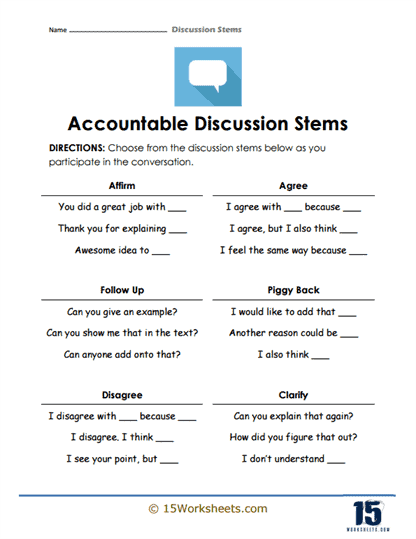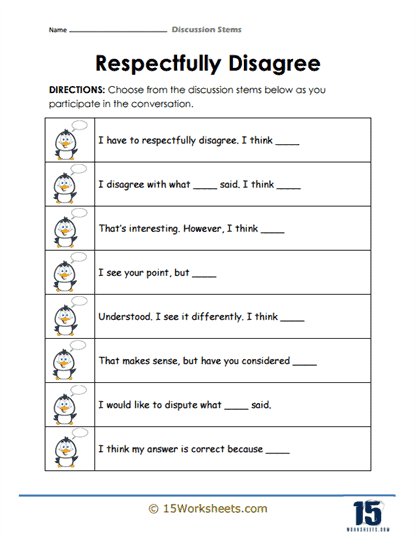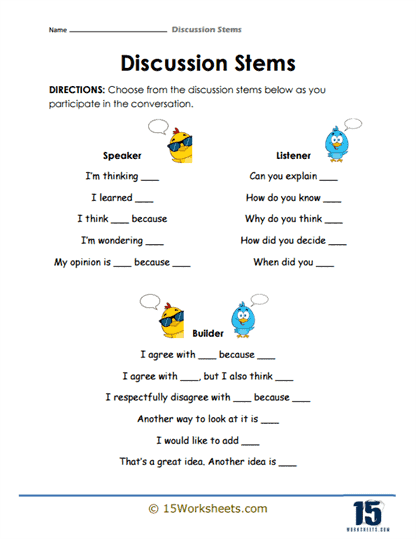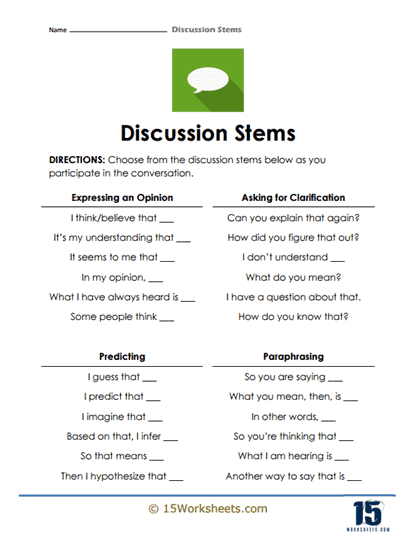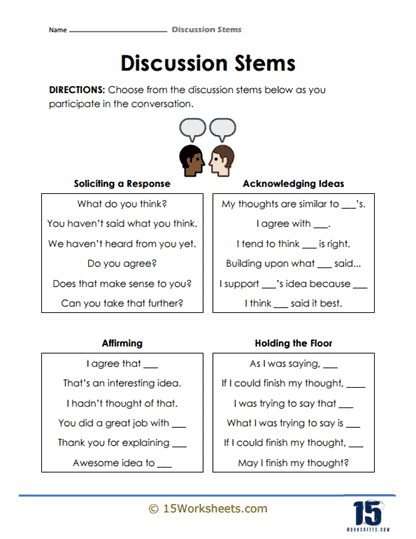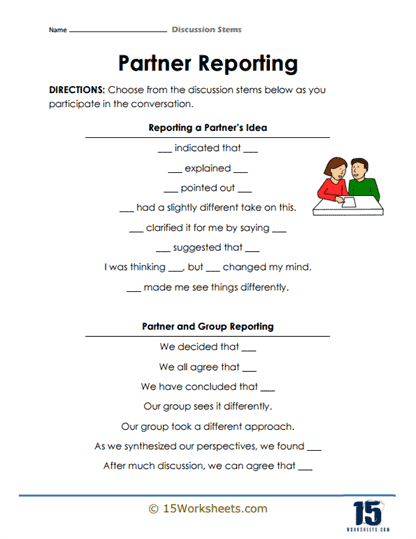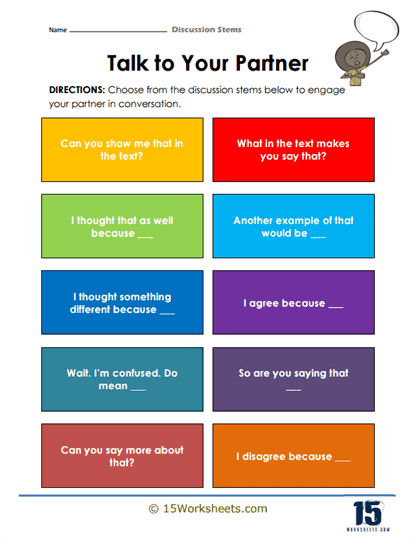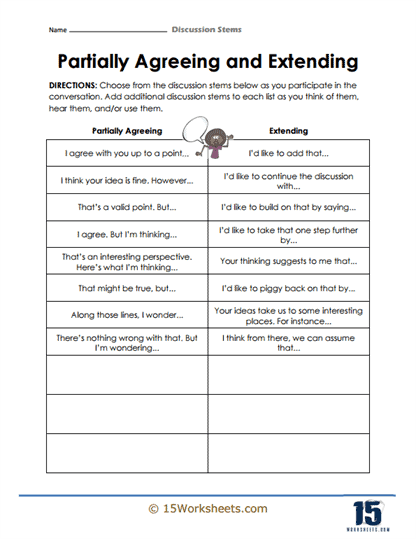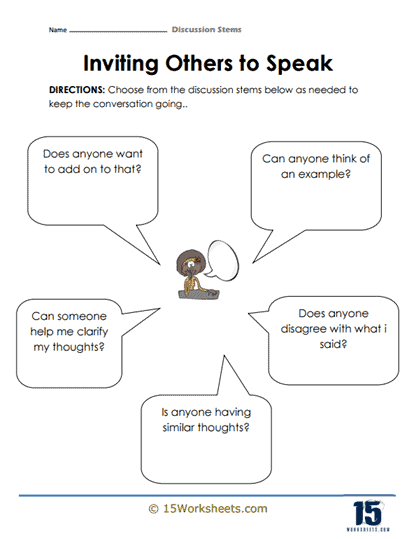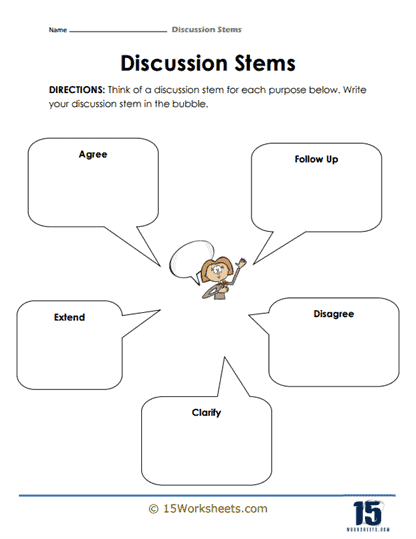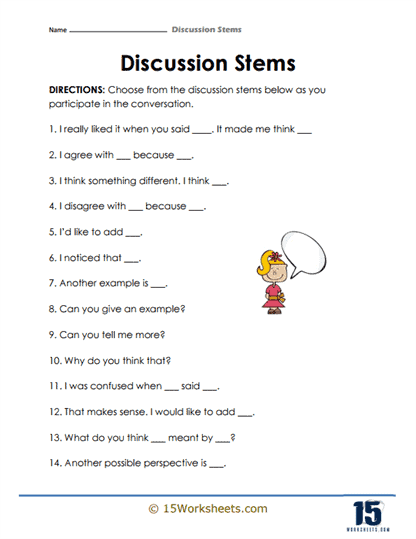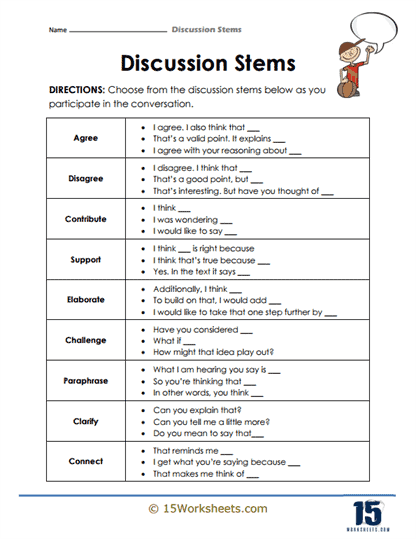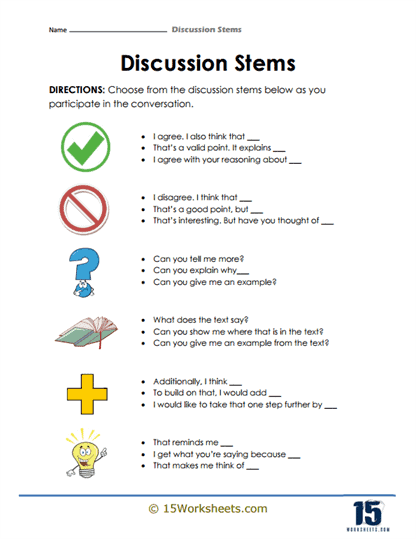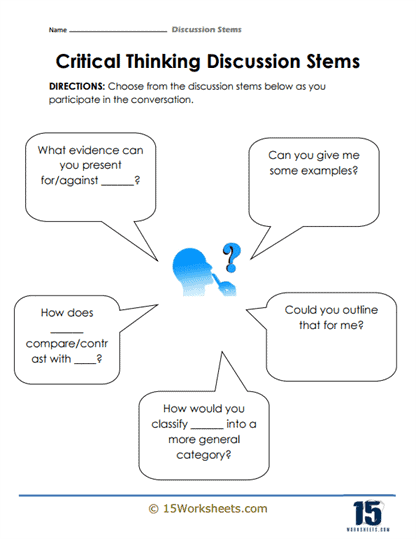Discussion Stems Worksheets
All About These 15 Worksheets
Engaging students in meaningful discussions is an essential aspect of their education, fostering critical thinking, communication skills, and the ability to express diverse perspectives. This series of 15 worksheets on Discussion Stems is thoughtfully designed to empower students with the tools they need to actively participate in discussions, articulate their thoughts effectively, and engage with others respectfully. Each worksheet focuses on a specific aspect of discussion skills, providing students with structured prompts and exercises to enhance their communication abilities and promote a collaborative learning environment.
The series begins with the “Accountable Discussion Stems” worksheet, which emphasizes the importance of responsible and thoughtful communication during group discussions. Students will learn how to actively participate, listen attentively, and contribute meaningfully using accountable discussion stems. Through these worksheets, students will:
- Engage in purposeful dialogue and develop their communication skills;
- Practice sharing information, ideas, and reflections with a partner using specific discussion stems;
- Learn to respectfully agree or disagree, make connections between ideas, and enhance their analytical skills;
- Practice using discussion stems to initiate and maintain conversations with their peers, fostering interpersonal skills and creating a collaborative learning environment;
- Explore discussion stems that enable them to express partial agreement while building upon existing arguments and contributing thoughtfully;
- Recognize the importance of inclusivity by using discussion stems to encourage others to share their perspectives and ensuring everyone’s voice is heard;
- And develop critical thinking skills through discussion stems that prompt analysis, evaluation, and the application of knowledge.
Through this series of engaging worksheets, students will develop their communication skills, enhance critical thinking abilities, and learn how to engage in respectful and thoughtful discussions. By practicing the use of discussion stems, they will become more confident communicators, capable of expressing their thoughts effectively and embracing diverse viewpoints. Overall, these worksheets provide a comprehensive framework for fostering meaningful discussions and creating a vibrant and inclusive classroom environment.
What Is a Discussion Stem?
Many activities are part of a classroom to engage students in meaningful conversations. The purpose of these activities is to boost the students’ confidence and help them think out of the box. Similarly, a technique known as discussion stems helps promotes and initiate class discussions. These prompts of sentence stem act as conversation stimulators for any topic.
The sentence stems are the beginning words or phrases at the starting of a sentence that kickstart a talk session in a classroom or any group of people. It is very different from just asking the students to discuss a topic in class. Discussion stems are more systematic about the learning process by streamlining the thoughts. This gives a rhythm to the discussions.
What Is The Difference Between Sentence Stems And Sentence Frames?
A sentence frame has a fill-in-the-blank structure to add details about any idea. They can exist in any form, such as analysis or describing a cause and effect relationship. On the other hand, sentence stems are conversation starters that always begin a sentence.
Examples of Sentence Frames
1. I can say this __________ because __________.
2. Why did __________ happen __________ ?
3. The effect of __________ on __________ is __________.
4. Both ____ and _______are ______.
5. I dislike poet’s _______ which shows_________in his work.
Why are Discussion Stems Important for Students?
The discourse allows students to explore the reasons for engagements and understand the behavioral patterns for each kind of discussion. The discussion stems aid the students with what to expect from each type of discussion and how to formulate the answers in a short time.
Types of Discussions
Academic Discussion
Some introductory sentence stems help in educating others. They also combine with other types of discussion stems and give the discussion a new perspective. To implement this discussion, you must create phrases that promote learning about new things.
Student Feedback
Give phrases to the students to formulate their feedback on any topic and answer them so that their perspective develops quickly. Always test the discussion stems on yourself. If you are reading a book in class, showing a film, or reciting poems, write down the stems and try to answer as the teacher and then ask the students to give feedback, starting with the prompts of sentence stems.
Accountable Discourse
Give your students a Ted talk or a multicultural passage from any conference to find out how they form their opinion about it. This is called cultural response development. One of the discussion types that is now positively promoted in class is an accountable discourse in culture. It brings more inclusivity to a class of different backgrounds.
Examples of Sentence Stems for Discussion
Below are some discussion stems that you could use in your classroom.
1. I like…
2. I wish…
3. I wonder…
4. I was not too fond of that because …
5. Could you tell me more about…
6. I respectfully disagree with…..
7. To summarize …
8. Putting it all together …
9. In conclusion …
10. To wrap things up …
11. To review …
12. In short …
13. All in all …
14. All things considered…
15. It was based on the findings of …
16. As seen by …
17. As explained by …
18. With regards to …
19. Based on the findings of …
20. As seen by …
21. As explained by…
22. The claims are invalid …
23. What I find interesting about…
24. The whole ordeal makes me…
25. The author seems…

